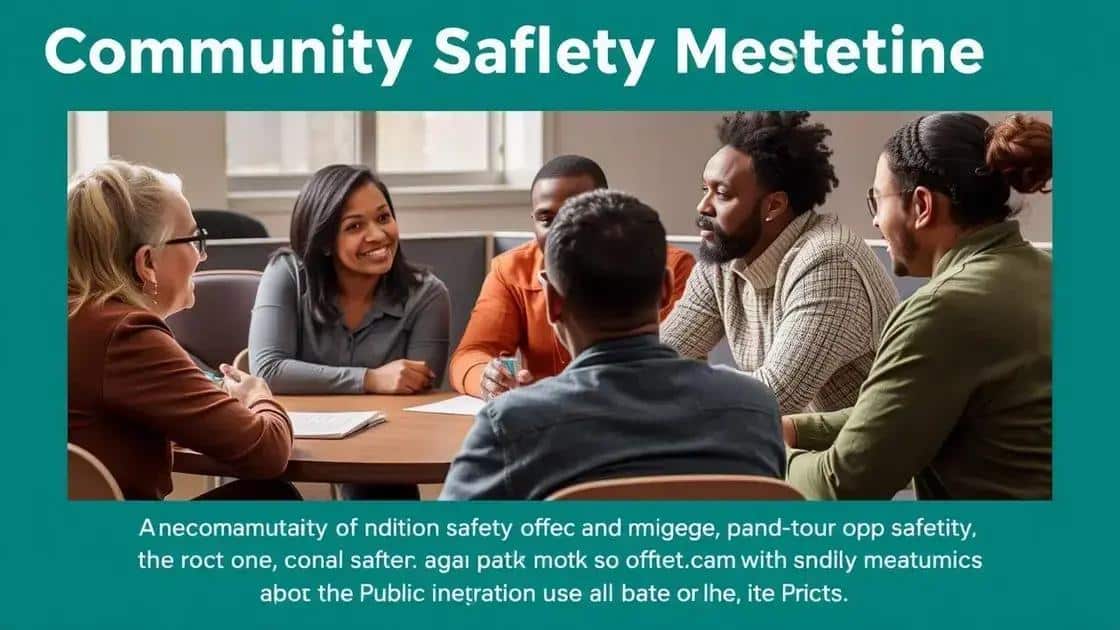Do public safety announcement: staying informed and safe

Public safety announcements are crucial communications that inform communities about emergencies, provide clear action steps, and enhance public safety through timely and effective messaging.
Do public safety announcement initiatives play a crucial role in keeping communities informed during emergencies. Have you ever wondered what makes these alerts so effective? Let’s dive into how they work and why your awareness matters.
Understanding the importance of public safety announcements
Understanding the importance of public safety announcements is essential for all communities. These announcements play a vital role in keeping citizens informed and prepared during emergencies.
When a crisis occurs, timely and effective communication can save lives. People need to know what to do and where to go. Public safety announcements provide clear directions and updates that help everyone stay safe.
Why Awareness Matters
Being aware of public safety measures is key. Here are some reasons why:
- They provide critical information about local emergencies.
- They help prevent panic by delivering clear instructions.
- Community engagement increases confidence and readiness.
- They promote accountability and collaboration within the community.
In addition to informing the public, these announcements strengthen community resilience. When people know what to expect, they’re more likely to act responsibly and aid others in need.
How Public Safety Announcements Reach You
There are several channels through which public safety announcements are disseminated:
- Social media platforms allow for rapid sharing of information.
- Local news broadcasts deliver updates in real-time.
- Emergency alert systems send notifications directly to your phone.
- Community bulletin boards keep information accessible to everyone.
These various channels ensure that the information reaches as many people as possible, reinforcing the importance of communication during critical times. Utilizing multiple platforms ensures inclusivity, helping to reach those who might not follow traditional news.
How to effectively distribute safety information
Knowing how to effectively distribute safety information is crucial for protecting communities. It ensures people receive updates, understand what to do, and can act quickly during emergencies.
Utilizing various channels is essential for reaching a wider audience. This allows for better awareness and preparedness across different demographics. Traditional methods, like newspapers, still hold value, but modern technology plays a key role in spreading information swiftly.
Utilizing Multiple Channels
Consider these effective channels for distributing safety information:
- Social Media: Platforms like Facebook and Twitter can disseminate information rapidly. They allow for real-time updates and community engagement.
- Text Alerts: Signing up for local alerts via SMS can ensure information reaches people directly.
- Email Notifications: Regular newsletters or updates keep the community informed on safety tips and upcoming events.
- Community Meetings: Hosting gatherings not only shares information but also allows for engaging discussions on safety practices.
These channels enhance the ability to inform the public effectively. For instance, social media can spread messages quickly, while community meetings foster personal connections and understanding.
Clear and Concise Messaging
When it comes to distributing safety information, clarity is vital. Messages should be short, easy to understand, and actionable. It’s essential to focus on what the community needs to know and what actions they should take in an emergency.
Using appropriate language and visuals can help convey messages more effectively. Infographics, for example, can illustrate safety steps attractively and simply. Regularly reviewing and improving these messages ensures they remain relevant and effective for your audience.
Key components of a safety announcement

Knowing the key components of a safety announcement is essential for effective communication during emergencies. Each element plays a critical role in ensuring that the public receives clear and actionable information.
First, a good safety announcement should include a concise message. It should quickly inform the audience of the situation without unnecessary details. Clarity is vital; it allows people to understand what is happening and what they need to do.
Essential Elements to Include
Here are the main components that should be present in every safety announcement:
- What Happened: Provide a brief description of the incident or situation.
- What to Do: Clearly state the actions the audience should take to stay safe.
- Where to Go: Include specific locations if evacuation or assistance points are necessary.
- Contact Information: Offer numbers or websites where people can get additional help or updates.
Each of these components ensures that the message is effective and actionable. For instance, informing people about what to do can help prevent panic and guide them in taking the right steps.
Using Simple Language
It’s also important to use simple, easy-to-understand language. Avoid jargon or complex terminology that might confuse the audience. A safety announcement should speak directly to the public, using words that everyone can understand.
Additionally, the tone of the announcement should match the urgency of the situation. Keeping a calm and reassuring message helps the audience feel more secure during crises. By addressing concerns directly and showing empathy, communicators can build trust with the community.
Engaging the community: the role of social media
Engaging the community through social media is a powerful way to enhance public safety announcements. These platforms allow for rapid communication, making it easy to share important updates with a large audience in real-time.
Social media connects people, enabling officials to reach residents quickly and effectively, especially during emergencies. By sharing updates, safety tips, and resources, officials can ensure that the public stays informed.
Benefits of Using Social Media
Here are some advantages of engaging the community through social media:
- Instant Updates: Social media provides immediate access to information, which is critical during crises.
- Community Interaction: Encouraging dialogue helps build trust and transparency between officials and the community.
- Wider Reach: Posts can be shared and spread quickly, reaching people who might not receive traditional announcements.
- Visual Content: Sharing images and videos can make announcements more engaging and easier to understand.
These features make social media an essential tool in disseminating safety information. People are more likely to respond positively to messages that encourage interaction and foster community spirit.
Best Practices for Social Media Engagement
To maximize effectiveness, here are some best practices for using social media in public safety announcements:
- Be Clear and Concise: Keep messages straightforward, focusing on key points to avoid confusion.
- Respond Promptly: Engage with community questions and concerns to show responsiveness.
- Use Hashtags: Create specific hashtags for events or announcements to make information searchable.
- Share Regularly: Consistent posting keeps the community informed and aware of safety protocols.
By following these practices, social media can effectively enhance public safety communication. Regular engagement builds a culture of safety and awareness, helping to create a well-informed community.
Real-life examples of successful public safety announcements
Real-life examples of successful public safety announcements can offer valuable insights into effective communication strategies. These cases show how clear messaging and prompt action can make a difference during emergencies.
One notable example occurred during a natural disaster, where local authorities used social media platforms to issue evacuation orders. By providing real-time updates and safety tips, they ensured that residents were well informed and prepared. This swift action likely saved lives and minimized panic among the community.
Case Studies of Effective Announcements
Here are some key instances where public safety announcements proved to be critical:
- Hurricane Alerts: Coastal towns that provide timely alerts about approaching hurricanes have higher evacuation rates. People are more likely to heed warnings when they are communicated effectively.
- Health Alerts: In the event of a disease outbreak, public health agencies often use announcements to inform the public about symptoms and preventive measures. This helps reduce transmission rates significantly.
- Missing Persons: When local law enforcement issues alerts about missing children or adults, they often use social media and mobile notifications. These announcements mobilize the public for quick searches.
- Community Safety Events: Announcements about local safety workshops or training sessions can foster a sense of community and readiness. These events engage residents and provide them with crucial safety information.
Each of these examples highlights the importance of timeliness, clarity, and the right choice of communication channels. Engaging the community during emergencies makes them feel involved and empowered to act.
Lessons Learned
From these successful announcements, we learn that using multiple platforms increases reach and engagement. The effectiveness of a message often depends on how relatable and actionable it is for the audience. Tailoring announcements to the community’s needs helps build trust and encourages prompt reactions.
public safety announcements are vital tools for keeping communities informed and safe. By using clear messaging, multiple channels, and engaging the public, officials can ensure that messages are received promptly and accurately. Learning from successful real-life examples helps improve future communications, making communities stronger and more prepared for emergencies. Together, we can create a safer environment for everyone.
FAQ – Frequently Asked Questions about Public Safety Announcements
What are public safety announcements?
Public safety announcements are communications that inform the public about emergencies, safety tips, and important updates to help keep communities safe.
How can social media enhance public safety announcements?
Social media allows for rapid sharing of information, engaging the community, and reaching a broader audience, making it an effective tool for public safety communications.
What are key components of an effective safety announcement?
Key components include clear messaging about what happened, what actions should be taken, where to go for help, and providing contact information.
Why is community engagement important for safety announcements?
Engaging the community fosters trust, encourages prompt action during emergencies, and ensures that the public is well-informed and prepared.





